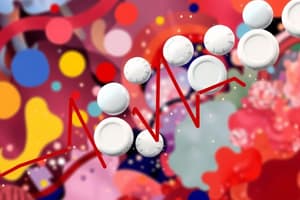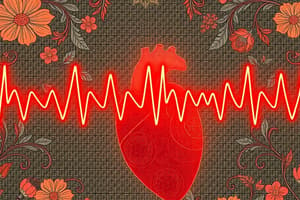Podcast
Questions and Answers
What is a non-pharmacological method to manage arrhythmias?
What is a non-pharmacological method to manage arrhythmias?
- Administrating adenosine
- Cardioversion
- Applying an ice bag to the face
- Stimulating the vagus nerve (correct)
Which of the following is not a pharmacological method to manage arrhythmias?
Which of the following is not a pharmacological method to manage arrhythmias?
- b blockers
- Digoxin
- Stimulating the vagus nerve (correct)
- Adenosine
What is the effect of stimulating the vagus nerve on heart rate?
What is the effect of stimulating the vagus nerve on heart rate?
- Variable response
- Bradycardia (correct)
- Normal heart rate
- Tachycardia
What is a possible next step after administering IV adenosine?
What is a possible next step after administering IV adenosine?
What is the purpose of applying an ice bag to the face in the context of arrhythmia management?
What is the purpose of applying an ice bag to the face in the context of arrhythmia management?
What is the purpose of rapid IV adenosine in a patient?
What is the purpose of rapid IV adenosine in a patient?
In which situation is synchronized cardioversion indicated?
In which situation is synchronized cardioversion indicated?
What is the primary goal of anti-arrhythmic drug therapy?
What is the primary goal of anti-arrhythmic drug therapy?
What is the term for a heart rate that is slower than normal?
What is the term for a heart rate that is slower than normal?
What is the primary indication for synchronized cardioversion?
What is the primary indication for synchronized cardioversion?
What is a common underlying cause of pericarditis in children?
What is a common underlying cause of pericarditis in children?
Which cardioversion technique is used to restore a normal heart rhythm?
Which cardioversion technique is used to restore a normal heart rhythm?
What is the primary goal of arrhythmia management in children?
What is the primary goal of arrhythmia management in children?
Which of the following is a common symptom of bacterial endocarditis?
Which of the following is a common symptom of bacterial endocarditis?
What is a potential complication of untreated arrhythmias in children?
What is a potential complication of untreated arrhythmias in children?
Flashcards are hidden until you start studying
Study Notes
Arrhythmia Management
- Applying an ice bag to the face can stimulate the vagus nerve and induce bradycardia.
- IV adenosine can be used to induce bradycardia, and afterwards, treatment can continue with beta blockers, digoxin, or other anti-arrhythmic drugs.
- Rapid IV adenosine administration is an anti-arrhythmic strategy to induce bradycardia.
- In patients with cardiovascular compromise, synchronized cardioversion is the indicated treatment.
Pediatric Arrhythmias
- Arrhythmias can occur in children, and their treatment options are available.
Bacterial Endocarditis
- Bacterial endocarditis is a condition with specific symptoms, which are important to recognize for timely diagnosis and treatment.
Studying That Suits You
Use AI to generate personalized quizzes and flashcards to suit your learning preferences.




